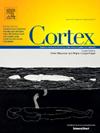Bodily perception links memory and self: A case study of an amnesic patient
IF 3.3
2区 心理学
Q1 BEHAVIORAL SCIENCES
引用次数: 0
Abstract
Episodic autobiographical memory (EAM) is a building block of self-consciousness, involving recollection and subjective re-experiencing of personal past experiences. Any life episode is originally encoded by a subject within a body. This raises the possibility that memory encoding is shaped by bodily self-consciousness (BSC), a basic form of self-consciousness arising from the multisensory and sensorimotor perceptual signals from the body. Recent studies in healthy subjects showed that embodied encoding improves EAM, with the involvement of the hippocampus. However, there are only few imaging studies to date, hippocampal data are not consistent, and the role of hippocampal damage is not understood. We investigated how different BSC states during encoding, modulate later EAM retrieval, in a patient with severe amnesia caused by rare bilateral hippocampal damage. We performed three separate behavioral experiments using immersive virtual reality. The patient showed consistently more difficulties recollecting information encoded in embodied versus disembodied states, particularly when asked to recall her perspective experienced at encoding. These results contrasted with the usual beneficial effect of BSC on EAM, and significantly differed from controls. These data provide consistent evidence that BSC impacts encoding and later reliving, and shows that the hippocampus is not just a critical structure for EAM, but also for effects of embodiment on memory. Additional fMRI data extend these findings by revealing that hippocampal-parietal connectivity mediates BSC-EAM coupling. Our findings plead for an important role of BSC in EAM, mediated by the hippocampus and its connectivity, leading to embodied memories that are experienced as belonging to the self.
身体感知连接记忆和自我:一个失忆症患者的案例研究
情景自传式记忆(Episodic autobiographical memory, EAM)是自我意识的组成部分,涉及对个人过去经历的回忆和主观再体验。任何生命片段最初都是由主体在身体内编码的。这就提出了一种可能性,即记忆编码是由身体自我意识(BSC)形成的,这是一种基本的自我意识形式,由来自身体的多感官和感觉运动感知信号产生。最近对健康受试者的研究表明,在海马体的参与下,具身编码改善了EAM。然而,迄今为止只有很少的影像学研究,海马数据不一致,海马损伤的作用尚不清楚。我们研究了一个由罕见的双侧海马损伤引起的严重失忆症患者,在编码过程中不同的BSC状态如何调节后来的EAM检索。我们使用沉浸式虚拟现实进行了三个独立的行为实验。患者在回忆有身状态与无身状态下编码的信息时始终表现出更大的困难,特别是当被要求回忆她在编码时的观点时。这些结果与BSC通常对EAM的有益作用形成对比,与对照组显著不同。这些数据提供了平衡记分卡影响编码和后来的记忆的一致证据,并表明海马体不仅是EAM的关键结构,而且对具体化对记忆的影响也很重要。额外的fMRI数据通过揭示海马-顶叶连接介导BSC-EAM耦合来扩展这些发现。我们的研究结果表明,BSC在EAM中发挥了重要作用,它由海马体及其连通性介导,导致被体验到属于自我的具身记忆。
本文章由计算机程序翻译,如有差异,请以英文原文为准。
求助全文
约1分钟内获得全文
求助全文
来源期刊

Cortex
医学-行为科学
CiteScore
7.00
自引率
5.60%
发文量
250
审稿时长
74 days
期刊介绍:
CORTEX is an international journal devoted to the study of cognition and of the relationship between the nervous system and mental processes, particularly as these are reflected in the behaviour of patients with acquired brain lesions, normal volunteers, children with typical and atypical development, and in the activation of brain regions and systems as recorded by functional neuroimaging techniques. It was founded in 1964 by Ennio De Renzi.
 求助内容:
求助内容: 应助结果提醒方式:
应助结果提醒方式:


